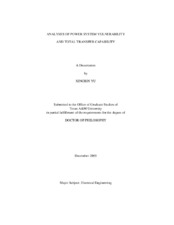| dc.description.abstract | Modern power systems are now stepping into the post-restructuring era, in which utility industries as well as ISOs (Independent System Operators) are involved. Attention needs to be paid to the reliability study of power systems by both the utility companies and the ISOs. An uninterrupted and high quality power is required for the sustainable development of a technological society. Power system blackouts generally result from cascading outages. Protection system hidden failures remain dormant when everything is normal and are exposed as a result of other system disturbances. This dissertation provides new methods for power system vulnerability analysis including protection failures. Both adequacy and security aspects are included. The power system vulnerability analysis covers the following issues: 1) Protection system failure analysis and modeling based on protection failure features; 2) New methodology for reliability evaluation to incorporate protection system failure modes; and, 3) Application of variance reduction techniques and evaluation. A new model of current-carrying component paired with its associated protection system has been proposed. The model differentiates two protection failure modes, and it is the foundation of the proposed research. Detailed stochastic features of system contingencies and corresponding responses are considered. Both adequacy and security reliability indices are computed. Moreover, a new reliability index ISV (Integrated System Vulnerability) is introduced to represent the integrated reliability performance with consideration of protection system failures. According to these indices, we can locate the weakest point or link in a power system. The whole analysis procedure is based on a non-sequential Monte Carlo simulation method. In reliability analysis, especially with Monte Carlo simulation, computation time is a function not only of a large number of simulations, but also time-consuming system state evaluation, such as OPF (Optimal Power Flow) and stability assessment. Theoretical and practical analysis is conducted for the application of variance reduction techniques. The dissertation also proposes a comprehensive approach for a TTC (Total Transfer Capability) calculation with consideration of thermal, voltage and transient stability limits. Both steady state and dynamic security assessments are included in the process of obtaining total transfer capability. Particularly, the effect of FACTS (Flexible AC Transmission Systems) devices on TTC is examined. FACTS devices have been shown to have both positive and negative effects on system stability depending on their location. Furthermore, this dissertation proposes a probabilistic method which gives a new framework for analyzing total transfer capability with actual operational conditions. | en |


